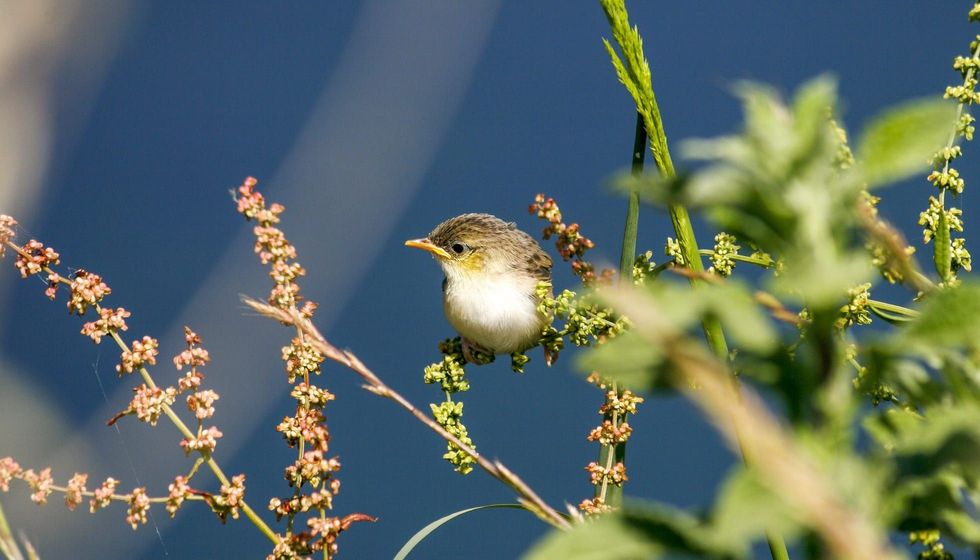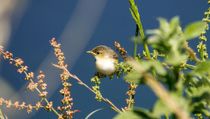The New World fan-tailed warbler (Euthlypis lachrymosa), often classified in the monotypic genus Basileuterus, is a common songbird. The species derives its name from its magnificent long white-tipped tail that it gracefully spreads open to display a fan-like motion.
The bird is primarily known to be sedentary. These birds are native to North America and Central America. In winter, the distribution in Chihuahua and Sonora tends to migrate towards the south.
The species has not been attributed a threatened or endangered status despite its thin population distribution. They're pretty common local birds and can be found abundantly throughout Mexico, Guatemala, Honduras, Nicaragua, and El Salvador. No major threats have been identified that can potentially render the species vulnerable. However, pollution and large-scale deforestation must be curbed for sustainable habitat.
For more relatable content, check out these flycatcher facts and umbrellabird facts for kids.
Fan-Tailed Warbler Interesting Facts
What type of animal is a fan-tailed warbler?
The fan-tailed warbler (Basileuterus lachrymosus) of the Parulidae family is a species of bird belonging to the genus Basileuterus. It is also scientifically called Euthlypis lachrymosa.
What class of animal does a fan-tailed warbler belong to?
The species has been classified under the class Aves and Passeriformes order.
How many fan-tailed warblers are there in the world?
According to the latest computations, around 50,000-499,999 adult birds are in current existence throughout their geographical range. However, the population trend also exhibits a significant decrease which implies that some precautionary measures are mandatory to protect the bird population from a vulnerable status.
Where does a fan-tailed warbler live?
Endemic to North America and Central America, the geographical range of these birds includes northern Mexico, Nicaragua, Guatemala, El Salvador, and Honduras.
At the end of the spring season, they can be found in areas of North Sonora and Chihuahua. Vagrant groups have also been spotted in New Mexico, Texas, and Southeastern Arizona.
If you're looking for the fan-tailed warbler, Texas is where the bird can be found in abundance, and if you're rooting for the not-so-similar streaked fan-tailed warbler, France would be your ideal place to visit in June.
These birds can be found near ground surfaces, sometimes pursuing the nine-banded armadillo or accompanied with other passerines, mostly foraging for swarms of ants and other insects in the near vicinity.
What is a fan-tailed warbler's habitat?
The species is not suited to wide-ranging habitats. These birds inhabit semi-deciduous and evergreen forest regions and prefer undisturbed rocky areas such as ravines and mountain foothills.
Who do fan-tailed warblers live with?
Fan-tailed warblers can dwell individually, form pairs, or even move about in flocks comprising mixed bird species.
How long does a fan-tailed warbler live?
No conclusions can be made regarding the lifespan of the forest-dwelling fan-tailed warbler of the Parulidae family, owing to the lack of adequate description. However, warblers generally have a maximum life expectancy of two years in the wilderness.
How do they reproduce?
The behavior of the species during the breeding season lacks a detailed description. However, a fan-tailed warbler nest is constructed out of pine needles, grasses, and dried leaves.
Normally the females construct the nest within eight days and lay two to four eggs. The nest is built on the ground, concealed under leaf litters. The latest research has revealed that females often desert their eggs and nestlings during the later stages of the breeding cycle.
What is their conservation status?
The species has been rendered a certification of Least Concern by the International Union for Conservation of Nature (IUCN) Red List due to abundance in its populations throughout different parts of the world.
Fan-Tailed Warbler Fun Facts
What do fan-tailed warblers look like?
The species (Euthlypis lachrymosa) has a dark gray upperpart and yellow underparts. The head is black with a patch of yellow on its crown and white eye-crescents. The fan-tailed warbler wings and tail are dark gray, and the foreface is black-colored while the feather edges are white-tipped.
The flanks are tawny-yellow hued, while the iris is black. The plumage of a juvenile is duller in coloration with ash gray upperparts and head. The long tail with white streaks at the edges renders a unique identification to the species.
How cute are they?
These small-sized birds define cuteness! With their bright and beautiful plumage, these birds of the Basileuterus genus are head turners.
How do they communicate?
A warbler is popular for its warbling song in a soothing voice. Have you heard a fan-tailed warbler song or even listened to a fan-tailed warbler sound? These birds interact via a range of calls and sounds such as 'wee wee wee wee wee wee-cher', the high-pitched 'schree', 'tseeng', and the short 'si'.
How big is a fan-tailed warbler?
The average length of the fan-tailed warbler (Basileuterus lachrymosus) is around 5.8-6.3 in (14.5-16 cm). The bird is comparatively larger than the small-sized yellow warbler measuring approximately 4.7-5.1 in (12-13 cm) in length.
How fast can a fan-tailed warbler fly?
The flight speed of the species is currently a mystery, but the average speed range of the warblers is around 30 mph (48 kph). It can be anticipated that the fan-tail warbler has a similar speed. The upper elevation limit of these birds has been recorded at 3,937 ft (1,200 m).
How much does a fan-tailed warbler weigh?
The fan-tailed warbler (Basileuterus lachrymosus) weighs in the range of 0.02-0.04 lb (10–21 g).
What are the male and female names of the species?
The fan-tailed warbler male and female are regarded as a cock and hen, respectively.
What would you call a baby fan-tailed warbler?
The baby of a fan-tailed warbler is lovingly regarded as a chick. Formally, names like hatchling and nestling are also used.
What do they eat?
The fan-tailed warbler of the Basileuterus genus is primarily insectivorous as it loves to indulge in foraging and preying on multiple insects and invertebrates. These birds are often spotted following army ants. Generally, they stay close to the ground, foraging among rocks, grasses, and leaves.
Are they poisonous?
These bright and beautiful little birds are completely nonvenomous. Apart from allergies, they do not pose any life-threatening dangers to humans.
Would they make a good pet?
In several countries, it is a criminal offense to keep wild birds as pets. The USA has implemented strict laws to curb the practice of rearing birds suited to the wilderness.
Similar to the hyacinth macaw, the small-sized fan-tailed warbler might prove to be a great pet. If you live in Central America or North America, you might even spot one in your backyard! However, the species must not be removed from its forest habitat.
Did you know...
Are you aware of the fan-tailed warbler meaning or fan-tailed warbler symbolism? Birds are believed to be God's messengers. Warblers are known for their pleasing warbling songs. Their voice is extremely refreshing. With their songs, these birds are considered to be harbingers of joy and mirth. Though this is not factually proven, it is a lovely meaning.
Do fan-tailed warblers migrate?
Euthlypis lachrymosa of genus Basileuterus can be called partially migratory as vagrant populations have been observed in Texas, New Mexico, and Arizona in winter.
Are fan-tailed warblers endangered?
The fan-tailed warblers have not qualified to the endangered zone yet. They're plentiful, with populations scattered throughout Nicaragua and northern Mexico.
Between 50,000-499,999 mature birds are currently thriving within their habitat. Presently, the species doesn't require protection, but some preventive measures must be undertaken to stop the declining population trend. Exploitative human activities such as clearings of forests must be discouraged so that these birds can have a secure forest habitat.
Here at Kidadl, we have carefully created lots of interesting family-friendly animal facts for everyone to discover! Learn more about some other birds from our blackpoll warbler facts and palm warbler facts pages.
You can even occupy yourself at home by coloring in one of our free printable bird coloring pages.
Second image by Francesco Veronesi.









